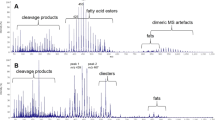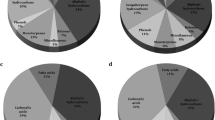Abstract
Individual differences in flank gland secretions were examined among males of the monogamous shrewCrocidura russula during the breeding and nonbreeding seasons. Gas chromatography was used to measure intra- and interindividual variation of flank gland secretions of free-ranging shrews from different populations. The number of compounds detected by gas Chromatographic analyses was correlated with body mass, flank gland size, and the presence of blood parasites in individual shrews. Very few compounds were detected from the flank gland area of juvenile males. After they reached sexual maturity, however, the number of compounds detected from the flank gland secretions increased significantly. At the beginning of the reproductive season 48 different compounds were detected from male flank gland secretions. In the middle of the breeding season 70 compounds were detected, while only 11 compounds were detected during the nonbreeding season. Few compounds were common to all males. There were more volatile compounds in the flank gland secretions of males in the beginning of the breeding season than later in the breeding season. Males from the same population had fewer differences in the elution profile of compounds than males from different populations indicating that individuals from a distinct population have similar elution profiles of compounds and that each population has its own type of elution profile. No correlations were found between the number of compounds detected by gas chromatography for each male and the male's body mass or flank gland size. Blood parasites (trypanosomes,Trypanosoma crocidurae) were found in only three of 30 males investigated.
Similar content being viewed by others
References
Albone, E. S. 1984. Mammalian Semiochemistry, The Investigation of Chemical Signals between Mammals. John Wiley & Sons Ltd. Chichester.
Ärnbäck-Christie-Linde, A. 1914. On the cartilago palatina and the organ of Jacobson in some mammals.Morphol. Jahrb. 48:343–364.
Balakrishnan, M., andAlexander, K. M. 1976. Hormonal control of scent marking in the indian musk shrew,Suncus murinus viridescens (Blyth).Horm. Behav. 7:431–439.
Balakrishnan, M., Sokolov, V. E., andBasurmanova, O. A. 1986. Further observations on the ultrastructure of the flank gland of the musk shrew,Suncus murinus viridescens (Blyth).Proc. Indian Acad. Sci. (Anim. Sci.) 95:667–675.
Beauchamp, G. K. 1976. Diet influences attractiveness of urine in guinea pigs.Nature 263:587–588.
Benzecri, J.-P. 1973. L'analyse des données. Vol. 2, l'analyse des correspondances. Dunod, Paris.
Besançon, F. 1984. Contribution á l'étude de la biologie et de la stratégie de reproduction deCrocidura russula (Soricidae, Insectivore) en zone tempérée. PhD dissertation. Lausanne.
Brown, R. E. 1979. Mammalian social odors: A critical review, pp. 103–162,in J. S. Rosenblatt, R. A. Hinde, C. Beer, and M.-C. Busnel (eds.). Advances in the Study of Behavior, Vol. 10. Academic Press, New York.
Brown, R. E. 1985a. The rodents I: Effects of odours on reproductive physiology (primer effects), pp. 245–344,in R. E. Brown and D. Macdonald (eds.). Social Odours in Mammals, Vol. I. Clarendon Press, Oxford.
Brown, R. E. 1985b. The rodents II: Suborder Myomorpha, pp. 345–417,in R. E. Brown and D. Macdonald (eds). Social Odours in Mammals, Vol. I. Clarendon Press, Oxford.
Brown, R. E., andMacdonald, D. 1985. Social Odours in Mammals. Clarendon Press, Oxford.
Brown, R. E., andSchellinck, H. M. 1992. Interactions among the MHC, diet and bacteria in the production of social odors in rodents, pp. 175–181,in R. L. Doty and D. Müller-Schwarze (eds.). Chemical Signals in Vertebrates 6. Plenum Press, New York.
Brumpt, E. 1923. Description d'une nouvelle espèce de trypanosomeTrypanosoma crocidurae chez une musaraigne (Crocidura russulus).Ann. Parasitol. 1:262–264.
Cantoni, D. 1990. Etude en milieu naturel de l'organisation sociale de trois espèces de musaraignes,Crocidura russula, Sorex coronatus etNeomys fodiens (Mammalia, Insectivora, Soricidae). PhD dissertation. Lausanne.
Cantoni, D. 1993. Social and spatial organization of free-ranging shrews,Sorex coronalus andNeomys fodiens (Insectivora, Mammalia).Anim. Behav. 45:975–995.
Cantoni, D., andRivier, L. 1992. Analysis of the secretions from the flank glands of 3 shrew species and their possible functions in a social context, pp. 99–106,in R. L. Doty and D. Müller-Schwarze (eds.). Chemical Signals in Vertebrates 6. Plenum Press, New York.
Cantoni, D., andVogel, P. 1989. Social organization and mating system of free-ranging greater white-toothed shrews,Crocidura russula. Anim. Behav. 38:205–214.
Cockburn, A. 1991. An Introduction to Evolutionary Ecology. Blackwell Scientific Publication, London.
Croin Michielsen, N. 1966. Intraspecific and interspecific competion in shrewsSorex araneus L. andSorex minutus L.Arch. Neer. Zool. 17:73–174.
Dryden, G. L., andConaway, C. M. 1967. The origin and hormonal control of scent production inSuncus murinus.J. Mammal. 48:420–428.
Eadie, W. R. 1938. The dermal glands of shrews.J. Mammal. 19:171–174.
Edrissian, G. H., Farhang-Azad, A., andNeronov, V. M. 1976. Trypanosomes of small mammals in Iran.J. Wildl. Dis. 12:497.
Eisenberg, J. F., andKleiman, D. G. 1972. Olfactory communication in mammals.Annu. Rev. Ecol. Syst. 3:1–32.
Erlinge, S., Sandell, M., andBrinck, C. 1982. Scent-marking and its territorial significance in stoats,Mustela erminea.Anim. Behav. 30:811–818.
Favre, L., andVogel, P. 1992. Multilocus probes reveal a low polymorphism in the greater whitetoothed shrew. Second International Conference on DNA Fingerprinting, Belo Horizonte, Brazil (abstract).
Genoud, M. 1981. Contribution à l'étude de la stratégie énergétique et de la distribution écologique deCrocidura russula (Soricidae, Insectivore) en zone tempérée. PhD dissertation. Lausanne.
Genoud, M. 1988. Energetic strategies of shrews: ecological constraints and evolutionary implications.Mammal. Rev. 18:173–193.
Genoud, M., andVogel, P. 1990. Energy requirements during reproduction and reproductive effort in shrews (Soricidae).J. Zool. London 220:41–60.
Geoffroy-Saint-Hillaire, M. 1815. Mémoire sur les glandes odoriférantes des musaraignes.Mem. Mus. Hist. Nat. 6:299–311.
Harvey, P. H., andBradbury, J. W. 1991. Sexual selection, pp. 203–233,in J. R. Krebs and N. B. Davies (eds.). Behavioural Ecology: An Evolutionary Approach, 3 ed., Blackwell Scientific Publications, Oxford.
Johnsen, S. 1914. Über die Seitendrüsen der Soriciden.Anat. Anz. 46:139–149.
Johnston, R. E., andJernigan. P. 1994. Golden hamsters recognize individuals, not just individual scents.Anim. Behav. 48:129–136.
Kavaliers. M., andColwell. D. D. 1995. Discrimination by female mice between the odours of parasitized and non-parasitized males.Proc. R. Soc. London B 261:37–41.
Legendre, L., andLegendre, P. 1979. Ecologie Numerique, Vol. II. Masson. Paris, et les Presses de l'Université du Québec.
Mantel, N. 1967. The detection of disease clustering and a generalized approach.Cancer Res. 27:209–220.
Milinski, M., andBakker, T. C. M. 1990. Female sticklebacks use male coloration in mate choice and hence avoid parasitized males.Nature 344:330–333.
Milinski, M., andParker, G. A. 1991. Competition for resources, pp. 137–168,in J. R. Krebs and N. B. Davies (eds.). Behavioural Ecology: An Evolutionary Approach, 3 ed., Blackwell Scientific Publications, Oxford.
Murariu, D. 1971. Contributions à la connaissance du système glandulaire tégumentaire chezSorex araneus L. etTalpa europea L. (Mammalia, Insectivora).Trav. Mus. Hist. Nat. Grigore Antipa 11:424–435.
Murariu, D. 1972. Observations concerning the form, size, structure and spreading of the sebaceous and sudoriferous glands in theErinaceus europaeus L.,Crocidura leucodon Herm, andNeomys fodiens Schreb. (Mammalia, Insectivora).Trav. Mus. Hist. Nat. Griegore Antipa 12:393–405.
Murariu, D. 1973. Données macro-et microscopiques sur les organes glandulaires latéraux chezSorex araneus L.,Neomys fodiens Schreb. etCrocidura Leucodon Herm, de Roumanie.Trav. Mus. Hist. Nat. Griegore Antipa 13:445–458.
Mykytowicz, R., andGoodrich, B. S. 1974. Skin glands as organs of communication in mammals.J. Invest. Dermatol. 62:124–131.
Natynczuk, S. E., andMacdonald, D. W. 1994, Analysis of rat haunch odor using dynamic solvent effect and principal component analysis.J. Chem. Ecol. 21:941–957.
Newman, K., andTang Halpin, Z. 1988. Individual odours and mate recognition in the prairie vole,Microtus ochrogaster. Anim. Behav. 36:1779–1787.
Niethammer, G. 1962. Die (bisher unbekannte) Schwanzdrüse der Hausspitzmaus,Crocidura russula (Hermann, 1780).Z. Saeugetierkd. 27:228–234.
Pearson, O. P. 1946. Scent glands of the short-tailed shrew.Anat. Rec. 94:615–629.
Platt, W. J. 1976. The social organization and territoriality of short-tailed shrew (Blarina brevicauda) populations in old-field habitats.Anim. Behav. 24:305–318.
Poduschka, W. 1977. Insectivore communication, pp. 600–633,in T. A. Sebeok (ed.). How Animals Communicate. Indiana University Press, London.
Poduschka, W., andWemmer, C. 1986. Observations on chemical communication and its glandular sources in selected insectivora, pp. 609–616,in D. Duvall, D. Müller-Schwarze, and R. M. Silverstein (eds.). Chemical Signals in Vertebrates 4. Plenum Press, New York.
Ricci, J. C., andVogel, P. 1984. Nouvelle méthode d'étude en nature des relations spatiales et sociales chezCrocidura russula (Mammalia, Soricidae).Mammalia 48:281–286.
Rissman, E. F. 1987. Social variables influence female sexual behavior in the musk shrew (Suncus murinus).J. Comp. Psychol. 101:3–6.
Rissman, E. F. 1989. Male related chemical cues promote sexual receptivity in female musk shrew.Behav. Neural Biol. 51:114–120.
Rivier, L., andBaumann, P. 1976. La spectrométrie de masse en biologie et médecine.Bull. Soc. Vaud. Sci. Nat. 73:1–18.
Salamon, M. 1996. Seasonal variations in the sternal scent secretion in the brushtail possum (Trichosurus vulpecula),in R. Apfelbach (ed.). Chemical Signals in Vertebrates VII. Pergamon Press, Oxford.
Schellinck, H. M., West, A. M., andBrown, R. E. 1992. Rats can discriminate between the urine odors of genetically identical mice maintained on different diets.Physiol. Behav. 51:1079–1082.
Sebek, K. 1978. Blood parasites of small mammals in western Hungary.Parasitol. Hung. 11:17–22.
Sigmund, L., andSedlacek, F. 1985. Morphometry of the olfactory organ and olfactory thresholds of some fatty acids inSorex araneus.Acta Zool. Fenn. 173:249–251.
Skeen, J. T., andThiessen, D. D. 1977. Scent of gerbil cuisine.Physiol. Behav. 19:11–14.
Stoddart, D. M. 1976. Mammalian Odours and Pheromones. The Camelot Press, Southampton, UK.
Tang-Martinez, Z., Mueller, L. L., andTaylor, G. T. 1993. Individual odours and mating success in the golden hamsterMesocricetus auratus.Anim. Behav. 45:1141–1151.
Tennant, L. E., Rissman, E. F., andBronson, F. H. 1987. Scent marking in the musk shrew (Suncus murinus).Physiol. Behav. 39:677–680.
Vaucher, C. 1971. Les Cestodes parasites des Soricidae d'Europe: Etude anatomique, révisions taxonomique et biologie.Rev. Suisse Zool. 78:1–113.
Vogel, P. 1972. Beitrag zur Fortpflanzungsbiologie der GattungenSorex, Neomys undCrocidura (Soricidae).Verh. Naturforsch. Ges. Basel 82:165–192.
Vogel, P. 1980. Metabolic level and biological strategies in shrews, pp. 170–180,in K. Schmidt-Nielsen, L. Bolis, and C. R. Taylor (eds.). Comparative Physiology: Primitive Mammals, Cambridge University Press, London.
von Holst, D. 1985. The primitive eutherians I: Orders Insectivore, Macroscelida and Scandentia, pp. 105–154,in R. E. Brown and D. W. Macdonald (eds.). Social Odours in Mammals, Vol. 1. Clarendon Press, Oxford.
Walter, G., andLiebisch, A. 1980. The ecology of some blood protozoa of wild small mammals in north Germany.Acta Trop. 37:31–40.
Author information
Authors and Affiliations
Rights and permissions
About this article
Cite this article
Cantoni, D., Favre, L., Tencalla, F. et al. Intra- and interindividual variation in flank gland secretions of free-ranging shrewsCrocidura russula . J Chem Ecol 22, 1669–1688 (1996). https://doi.org/10.1007/BF02272406
Received:
Accepted:
Issue Date:
DOI: https://doi.org/10.1007/BF02272406




